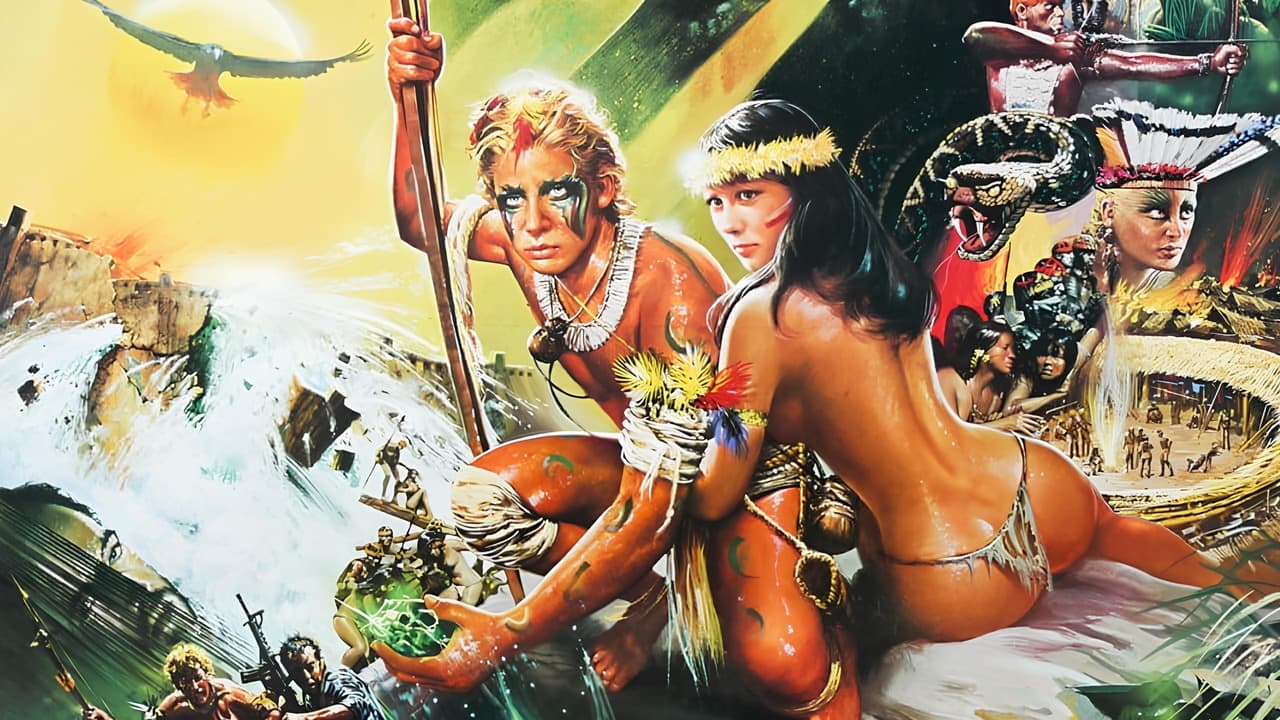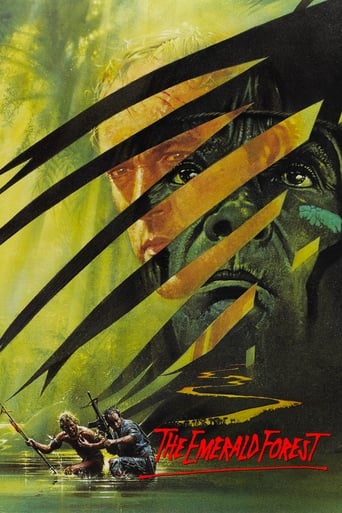

When this movie first came out, I was a kid, and to me it was pretty interesting and eye-opening. Certainly compared to doing homework and my paper route in the suburbs, this kid was pretty lucky to get kidnapped by "indians". He got to hang out and swim with naked girls, hunt animals, and fight. There's definitely some wish fulfillment and some fantasy in the film, which presents itself as a sort of "heart of darkness" tale of the encounter between civilization and nature. That's a good starting point, perhaps, for the problems with the film. We have basically 2 tribes, and one of them likes to take lots of drugs and have lots of sex, while the other one is brutal and cannibalistic. This neatly ties the 2 dominant ways that white colonists tend to look at indigenous cultures into a concrete dichotomy: the noble savage vs. the cannibal savage. Also interestingly, the film shows the father figure (Powers Boothe) as a would-be white savior, but his attempts to blow up the dam with dynamite are preempted by the magic of the noble tribesmen. Regardless of the political appeal of this conclusion, the film doesn't really offer any kind of answers for what is to be done to save the rain forests or the indigenous peoples or, more importantly, to help them save themselves by any means other than frogs and magic. It's just, like "Medicine Man" and other films of this type, using the "jungle" and its inhabitants as a means of drawing the audience in and giving us a fantasy version of indigenous life. The cast in the film is notably poor, especially Boorman's son Charley, who plays the kidnapped boy as an adolescent. To be fair, the script demands an awful lot of Charley Boorman, but he can't really deliver much of it. Meg Foster barely registers, and the film in general has a very paternalistic and patriarchal tone, almost totally concerned with the relationship between men who are fathers and sons. If, like me, you have fond memories of this one from your childhood, perhaps it's best to just leave them there. The film is very well- photographed, but all the scenes with "wild" animals look like somebody put the animals right there to be photographed. It suffers very greatly compared to, say, Herzog's films like "Fitzcarraldo" where instead of inserting tropical animals just to provide some momentary visual interest, the jungle even in its dangers is allowed to become "normal." We feel as if the tribes in Boorman's film live within a vacation destination or a zoo.It's also well-directed, but in the sensational way that Boorman seems to only know how. If you look at some of Boorman's other films, like "Zardoz" and "Excalibur", you'll see that he sort of lets actors do whatever they want, resulting in the more experienced actors totally dominating all the film's energy (arguably, in "Excalibur", that's part of the design of the film). Here, we have no real actors. While Boothe has a nice low-key demeanor, that only makes it more ridiculous when he grabs a machine gun and starts killing the "bad" natives like he was your average 80s action hero. It's somewhat of an admirable effort, considering how many other films you could see in the 80s that didn't offer the sort of escapist adventure, nor any of the message of this film -- however, it's deeply and intrinsically flawed and does not make up for in drama what it lacks in realism.
... View MorePelo amor de deus, this movie is certainly one of the most racist and ethnocentric movies ever made. Hard to believe that it is from 1985 and not 1885. Boorman illustrated the average white "civilized" persons imagination of "primitive" tribes who by and large behave like a bunch of monkeys. Or, worse than that, cannibalistic monkeys who disguise like African zombies from another white mans fantasy. The acting is so poor and clumsy that it is almost comical, and, worst of all, the fake "Indian" language is just a slightly distorted English with even the exact same amount of syllables as the English sentence would have. This movie so utterly ridiculous - and discriminatory - that its stupid colonialist disdainfulness towards indigenous people almost completely destroys its somewhat ecological message.
... View MoreThis 1985 action/adventure film is fairly heavy handed and tends to shy away from the ultra violent action movies of the 80s that starred the Stallones, the Schwarzeneggers, or the Lundgrens at the height of their career. Instead, this is more of an episodic film, based on a true story that is more melodramatic in nature with elaborate character development and a big glaring message about industry vs nature. Director John Boorman ('Deliverance', 'Hope and Glory', 'The Exorcist II') chose to film 'The Emerald Forest' on location in the Amazon rainforest, which gives us a beautiful glimpse at the native people, the wildlife, and its surroundings. This is one of Boorman's more direct stories he has put on film and the result is a satisfying look at what parents would do for their children.The first segment of 'The Emerald Forest' has us meeting a chief engineer named Bill (Powers Boothe), who is in the Amazon rainforest with his wife Jean (Meg Foster) and their two very young children. Bill is in charge of overseeing the construction of a giant dam that will restrict the flow of water to parts of the rainforest, which will flatten the land for future industrial and commercial buildings to be constructed. Boorman clearly shows which side he is on as he delicately shows us the beauty and wonder of the trees and animals, whereas the big bad city people are using their big tractors and fire to destroy the beautiful land.Bill and Jean's young son is stolen by an indigenous tribe located in the heart of the forest known as 'The Invisible People', which causes despair for the family. We cut to ten years later where Bill and Jean are still living in Brazil where the dam is almost fully built. They are still trying to repair their broken lives without their son through work and charity. Bill walks with a journalist through the forest and comes across his now grown boy (Charley Boorman) after ten years. and is a contributing member of this new tribe and about to go through some big rituals into full fledged manhood. Bill soon realizes that what was once his son, now belongs to this primitive tribe.The film switches gears and puts this reconnection on the back burner and focuses on another tribe, which is a much more violent people with more advanced weapons than the usual spears and rocks, known as the 'Fierce People', who are about to wage war on the peaceful 'Invisible People'. Meanwhile, the damn construction is nearing completion and the entire group of tribes have to keep moving further deep into the forest to avoid being killed or taken by authorities. And now Bill must make a big decision. Does he help his lost son and his tribe stand up and fight the bad guys and stop the dam, or does he move on, keeping his life's work in tact. It's a pretty powerful story.But Boorman doesn't focus very much on the reconnection or kidnapping of Bill's son, which in my opinion was a very vital and integral part of the story. Not much time is given to the initial kidnapping and quickly fast forwards ten years into the future. And when the reconnection happens between father and son, it should have been a bigger moment, but Boorman focuses on the nature vs industry aspect right away with the construction of the dam and the rival tribes. Then, the last climactic few scenes of the film is a straight up revenge flick where Bill and his son come to respect each other's decision to move on with their separate lives.Both Boothe and Foster turn in great performances as parents who are coping with the lost of one of their kids. Their anger and depression truly shows in their faces and body language throughout. 'The Emerald Forest' is a solid entry into the 80s action adventure category that stands on its own with its originality, despite the lack of hardcore action.
... View MoreI like to watch in pairs, and this was paired with Herzog's "Green Ants Dream."The central character here is a teen, played by the director's son, who is kidnapped by Amazonian Indians at six and raised in nature. There are threats, adventures, encounters with "civilization." They provide the focus of the energy in this thing. Its all about that energy which we take from the juice of adolescence, perceive as the energy of an action movie and conflate (as we are intended to) with the natural richness of the rainforest.Its a simple trick, but by gosh it works. Why is not a mystery: the teen drive is transformed into something pure here, done so by the actresses who play the teen Indian girls, lovely, and effectively nude. In order to underscore the point, the plot has them (importantly, as a group) kidnapped into civilization as a the complement of the original kidnapping. But the purpose here is prostitution. When someone knows what they are doing and delivers the goods, its always a remarkable thing. The narrative engineering conveys the lack of engineering, and makes us desire the purity of encountering things without artifice.Conveying this notion is then mixed with a completely unrelated message about the destruction of the rainforest and its central importance to the global ecology. Its rather dishonest, this, but because its such a noble cause we let it slip. But its a shame. In their defense, the acknowledge that just being native doesn't endow goodness: there is an "evil" tribe. Part of the tragedy is not shown: natives everywhere in the world aggressively damage the environment as much as their capabilities allow.The perfect delicacy of this puts "Apocalypto" to shame. Ted's Evaluation -- 3 of 3: Worth watching.
... View More